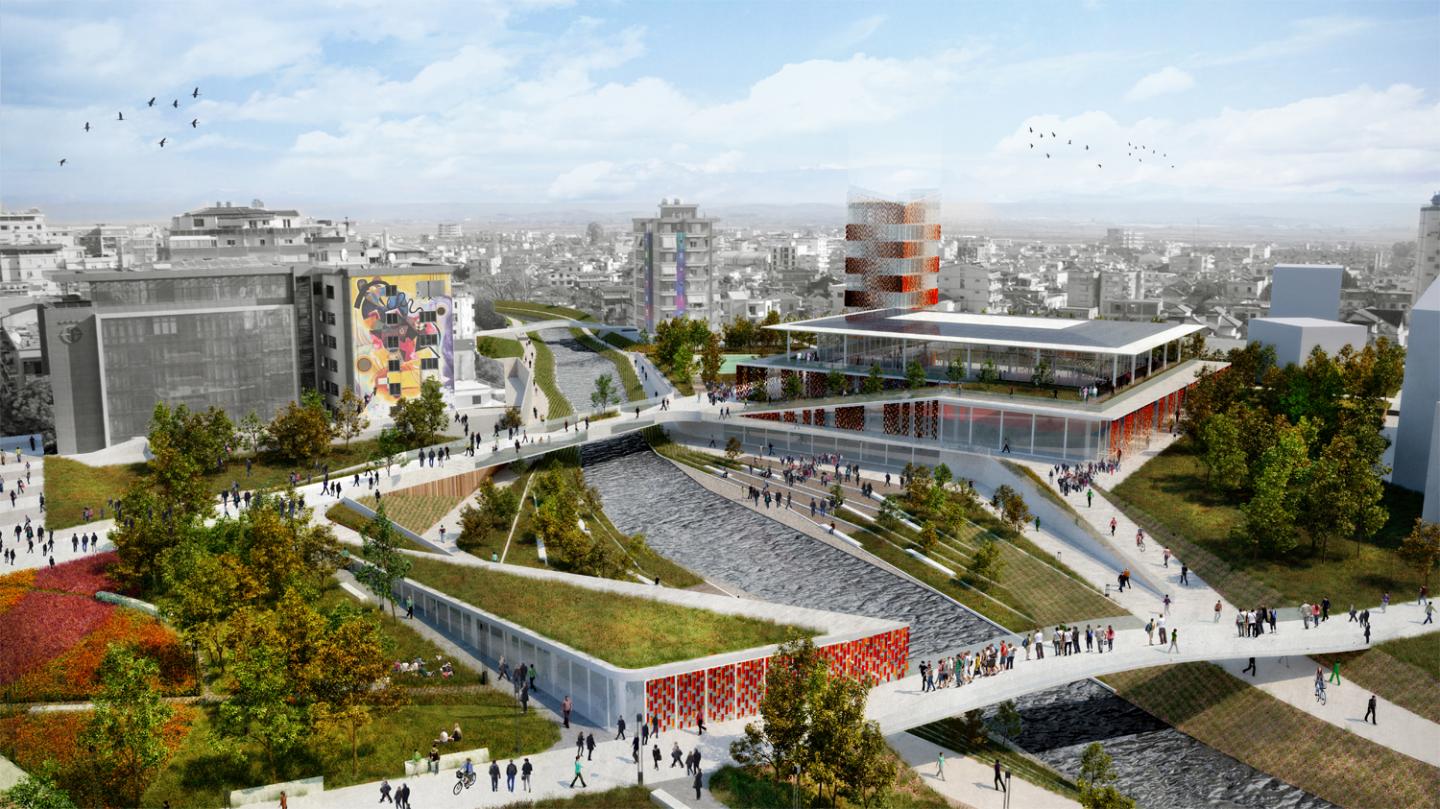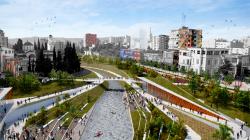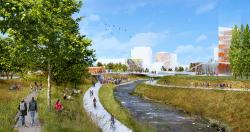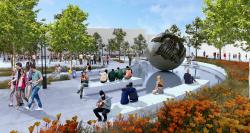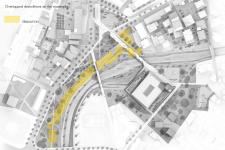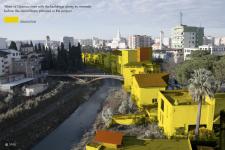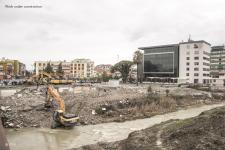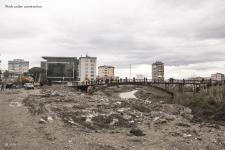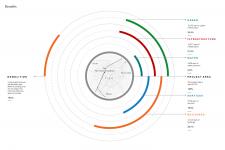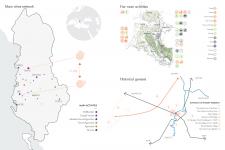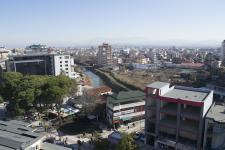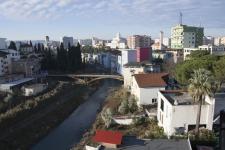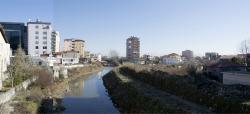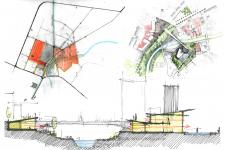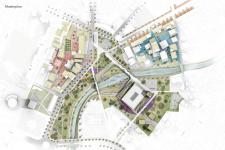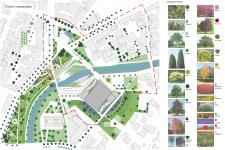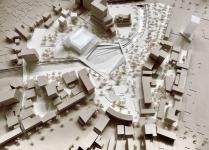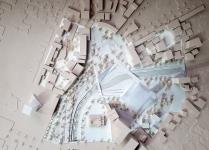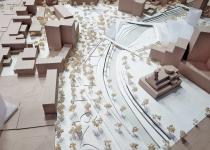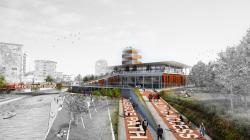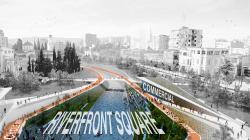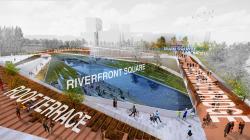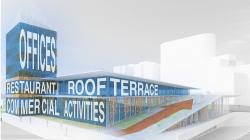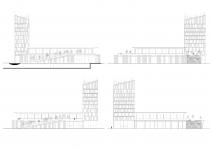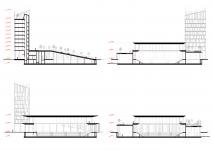The purpose of the project was to re-design the new city center, including its main square, the
waterfront and the sorroundings, covering an area of 60,000 square meters, in line with the current
trends in urban regeneration.
MAU Architecture proposes a project inspired by the most virtuous redevelopment model in the
European panorama, as the basis of an intelligent territorial planning that aims to use
contemporary solutions compatible with the urban environment, in order to ensure a better quality
of life for its inhabitants.
The project’s strategy aims to increase those specific elements that characterize Fier’s identity, to
achieve the reconstruction of a series of relationships that will positively condition the everyday life
of its citizens.
The city of Fier was established and organized along the banks of the river Gjanica, valorising it as
an active element of the city, this is a great opportunity for developing both the city and the natural
landscape at once. Bridges along the river have been as well a vital element for the entire system,
directly connecting two parts of the city.
Contrary to this original situation, the river is nowadays seen as a limit dividing the city on both sides,
where the western part is more developed than the eastern part. A new limit, spontaneous and
dense urban constructions have been built on both sides of the river, physically and visually
separating the two parts of the city each others. The spontaneous growth that has developed in
Albania since 1997 has dramatically increased the construction of abusive buildings, and this
practice has also affected the shores of the river, hampering its view and use.
So, the first intuition in the genesis of the project was the desire to bring back to Gjanica its role of
natural urban threshold, aiming to restore the river as the main generator of the city. The first step
in addressing the topic of the project was the analysis of the current state of the territory, especially
the bandwagon horizon over the Gjanica River, which over the years has been conditioned by
intense, irresistible construction, the operation will include the recovery demolishing of the abusive
buildings. The city’s reconnection with the river Gjanica is sought not only through the presence of
a new urban platform, but through a link to its broader and more complex territory towards
transparency, visibility, usability and access to the coast; a green relationship permits the
recognition of a permeable boundary within compact constructions, by enhancing visual
perception. Along the north shore of the river, the project proposes, in this regard, a promenade and a linear
park that balance spaces through a green road network with a multidimensional vision, due to
different paths and views; the southern part presents a new mixed use building and a park next to
it.
The relationship with the context and the existing structures, the features of a physiognomy
already rooted in the city’s landscape, will inevitably have the task of keeping together a complex
system of interrelated connections (historic roads, the cathedral, structures of the Communist era,
recent constructions) with the poles of new urban development. The project keeps the old axes of
the city by putting them in service only for the pedestrians, while the Europa Plaza square
becomes the generator of a third axis as a new element between the north and south of the city.
Reclaiming a direct link to the river shores establishes different flow rates at different heights (from
road level to river level), and make it possible to travel through the whole area in various ways and
speeds. On both sides of the river, a cycling system is developed as a fast flow (throughout the
city’s long river strategy), while on a higher level the main axes of the two existing bridges are
preserved and a third bridge is added, directly linking north and south parts of the city through a
sequence of green spots and resting areas. The physical center and cornerstone of the whole
system is designed as a riverfront amphitheater, enclosed between two bridges, allowing people to
enjoy the reclaimed shores of the Gjanica, providing an opportunity for creating a public space of
interaction. The linear park, with great variety of plants and trees species, softly connects the city with the
river’s north shore, and leads directly to the new pedestrian bridge and the Europa Plaza, which
becomes a new urban core aimed to activate interactions and increase urban quality; next to the
existing southern bridge, a small commercial building directly overlooks both the park and the river.
To regain a connection between the northern part and the southern part of the city, which is
nowadays totally disconnected from the center, the new building on the other side is designed as a
multifunctional landmark with the goal of reactivating this part of the city (along with the new
bridge). Its floating slabs let it be permeable to the views from north to south, and its big green
ramps and roof terrace make it integral part of the general masterplan as a public space itself.
As part of the project, an intensive process of reorganizing and redeveloping public spaces across
the city, functional rearrangement, and landscaping of river banks, will allow access only to buses,
pedestrians and cyclists. The public space is conceived as a catalyst for the upgrading of
neighboring buildings and the growth of new economic activities. Strengthening the public
transport will lead to a sharp change in citizens' tendencies to use the car, while the creation of a
protected lane along the linear park system will make possible to cycle through the entire historic
center. Streets, squares, parks and public spaces in general will not only work as functional elements of
urban development, but will become a fundamental component of the image and identity of the
city.
The project has just started its first phase, with the demolition of the buildings along the river.
2017
0000
location: Fier, Albania
client: Municipality of Fier
built area: 60.000 Sqm
architects: MAU Architecture
design team: Andrea Michelini, Amarda Velçani, Davide Cappochin, Giacomo Gola, Giancarlo Franchini,
Giuseppe Cappochin, Jacopo Berlendis, Roberto Franchini consultants: VIASTRADE S.R.L., REAN 95
photo credits: MAU Architecture
Favorited 4 times
